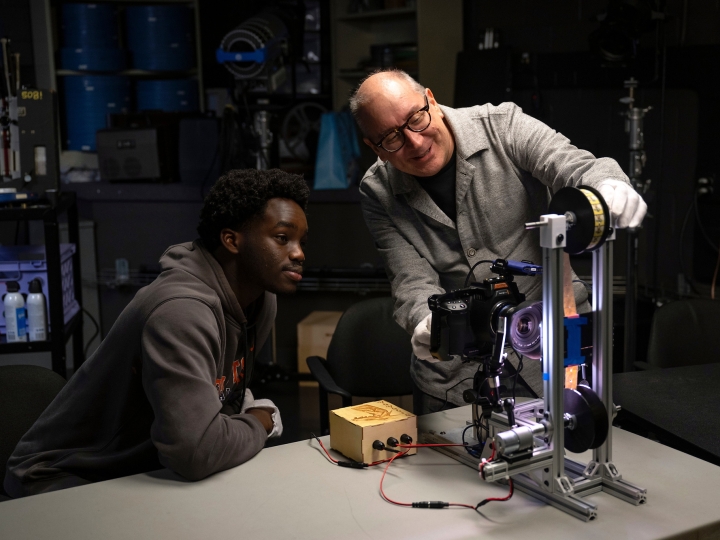From Vine to Wine
December 2, 2016
Bucknell University Professor Gary Grant studiously swirls the contents of his glass. Red liquid slides up the sides and nearly to the rim, but not over. He lets it settle, then pushes his nose deep inside and inhales.
Grant's eyes are open, but he doesn't appear to see the ELC Center Room, or the rows of cloth-covered tables scattered with stemware — or even his students, who are watching him with pens poised over their stained and battered notebooks.
He places the glass on the table, then smiles and nods. This is a good wine.
According to Grant, appreciating wine is not about drinking. It's about respect. Grant is teaching that respect to a group of Bucknell students aged 21 and older who are the first to take the new course UNIV 130: From Vine to Wine: An Introduction to Viticulture and Oenology.
Learning about wine is no different than learning about any other subject. Students need to pay attention, to read, to listen. They need to have patience. They need to understand that what they see isn't the only story being told.
"To understand what it takes to make a bottle of wine, you should really spend some time thinking about it and considering what you are experiencing," Grant explained. "You begin to appreciate what a vintner in Argentina goes through as opposed to what a vintner in Napa Valley goes through, and how they understand their land, their vineyards and their traditions of winemaking."
From Vine to Wine was a hot listing in the fall 2016 course catalog, but is capped at 18 students. To gain entry, each interested student completed a survey to detail their experience with wine.
"I wanted the students in the class to have a wide variety of experience," said Grant, a theatre & dance professor who is certified by the Society of Wine Educators. He has been holding tastings for University students, faculty and staff for more than a decade (see sidebar).
"Some students are interested in the industry or marketing. Others learned about wine in other cultures while studying abroad or from dining with their parents, and still others know absolutely nothing."
The students attend lectures and use a book called The University Wine Course. They have regular tastings with special guests, such as Italian winemaker Giorgio Rivetti and Pennsylvania Liquor Control Board wine buyer Steve Pollack. They record their experiences in a wine-tasting notebook and post reflective blog entries every week.
"As tasters, what they write about their experiences is very informative," said Grant. "Their descriptions of wine are becoming more nuanced, more like what you would read in a professional journal."
Tastings are an important part of the class, taking place once a week and lasting up to three hours. "I set a very formal atmosphere," said Grant. "When students walk in that room, they say, 'Whoa,' because there are tasting glasses and white placemats, the aroma wheel and scoring sheets. Students are required to spit out the wine in order to keep their senses sharp. I want to set the expectation that we're going to approach this sensory evaluation of wine very seriously."
Some lectures feature guests like local winemaker Chuck Zaleski '83. When he visited the classroom, Zaleski led students through a Riesling vertical, where they tasted every Riesling Fero Vineyards and Winery has produced since its first year.
But even in a class this different, there's no getting away from tests. From Vine to Wine exams are fairly typical — essays, true/false, multiple choice, fill-in-the-blanks — but with a twist: Students have to identify a mystery wine.
As it turns out, there are many ways to identify the structure and flavors of a wine. For their midterm and final exams, Grant's students must do it blind.
"We were allowed to have our tasting notebooks to jog our memories about aromas and taste profiles," said Emily Fischer '17, a theatre major. "We took our best guess and had to justify it. I guessed Merlot — I don't know if I'm right yet."
To learn to identify smells, and how to match them with flavors, students use a Le Nez du Vin, a gift from a Bucknell parent in support of the course. "It's got 54 little vials, each containing an aroma that's in wine," explained Grant. "Students smell the aromas and learn to recognize, after a while, what grapefruit, lemon, truffles and caramel, for example, smell like."
The tests are challenging because Grant believes that a person cannot fully appreciate a wine through tasting alone, as it's inexorably linked with the region and culture in which it is produced. Therefore, he insists that his students understand varietal differences, wine regions, winemaking techniques and cultural traditions.
"In the Republic of Georgia, for example, many winemakers don't use oak fermentation barrels or stainless steel tanks," Grant explained. "Instead, they produce wine in a qvevry, a terra cotta vat buried the ground. That's an ancient technique. Why do they do that? Why do they continue to do that, even today? Those are some of the questions I want my students to ask when they taste wine for that region."
Back in the ELC Center Room, the exacting and emotional language tumbling off the tasters' tongues grows louder with each pour.
"Long in the mouth." "Passionate." "Young and rugged." "Racy." "Rich." "Earthy." "Beautiful."
Grant stands in the center of it all, listening, watching, swirling his glass and smiling.

